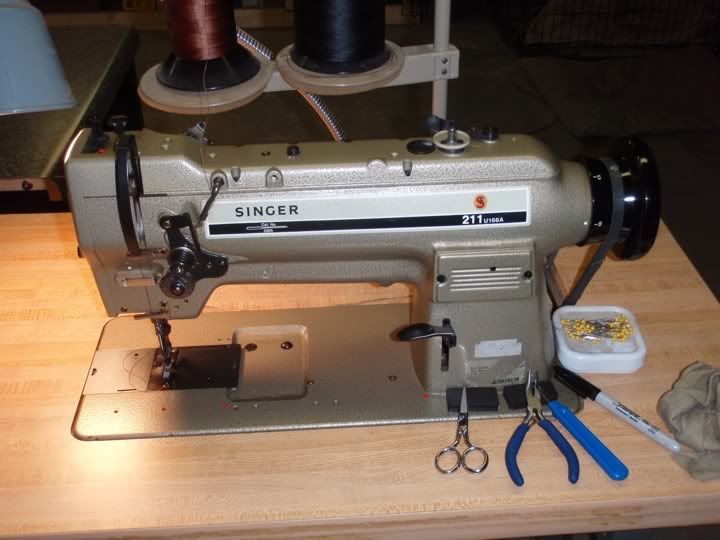MaulWalker
Sr Member
I’ve sewn on about seven different brands of machines. I am not going to recommend a particular brand of sewing machine, but rather give you some ideas of what to look for if you are in the market for a machine and where you might find one.
In the bad old days, sewing machines were often integrated into a piece of furniture –such as a credenza or table. Then manufacturers started making “portable” machines. That meant they were no longer integrated into furniture and you only needed two people to move them instead of three. Now, you can find extremely light-weight machines.
But that light weight comes at a price. Sewing machines are just that – machines. They have motors, gears, levers, etc. When one stops sewing, it may be because the timing is off' like your car. To save weight, most low-end sewing machines contain lighter motors and plastic parts.
New machines range from $99 to low four figures. Metal parts and heavier motors of course cost more. Even the most basic new machine has stitch width selection, stitch length selection, reverse, a handful of presser feet for designed for different applications, and a selection of different stitches. More expensive machines have heavier motors, more metal working parts, more feet, and many more stitches. I know several years ago Consumer Reports magazine reviewed sewing machines. You might want to look that article up.
Older machines are perfectly serviceable and will save you a considerable amount of money. You get the benefits of all those metal innards and heavy motors. Old Singers and Kenmores are excellent machines. You can find these machines on eBay, at yard sales, and flea markets. Another place to look for old machines is at a free-standing sewing machine store (not the sewing machine section at your local fabric store.) Many of these stores accept trade-ins and then resell the trade-ins.
Note: if you find a machine advertised as a zigzag machine, don’t worry. On these machines you set the stitch width to zero to get a straight stitch.
Now there are a number of machines that look like sewing machines and may sew but are primarily designed to do something else. These are quilting machines and embroidery machines. These special-purpose machines are much more expensive.
You may notice that some serious sewers have more than one machine. For instance, I know one costumer who has an old cast-iron Singer machine that only sews straight stitches, but it sews through leather like it was light-weight cotton. So it is reserved for leather work. Another costumer I know has an expensive machine that she uses for everyday and an inexpensive machine that travels with her to conventions.
In the bad old days, sewing machines were often integrated into a piece of furniture –such as a credenza or table. Then manufacturers started making “portable” machines. That meant they were no longer integrated into furniture and you only needed two people to move them instead of three. Now, you can find extremely light-weight machines.
But that light weight comes at a price. Sewing machines are just that – machines. They have motors, gears, levers, etc. When one stops sewing, it may be because the timing is off' like your car. To save weight, most low-end sewing machines contain lighter motors and plastic parts.
New machines range from $99 to low four figures. Metal parts and heavier motors of course cost more. Even the most basic new machine has stitch width selection, stitch length selection, reverse, a handful of presser feet for designed for different applications, and a selection of different stitches. More expensive machines have heavier motors, more metal working parts, more feet, and many more stitches. I know several years ago Consumer Reports magazine reviewed sewing machines. You might want to look that article up.
Older machines are perfectly serviceable and will save you a considerable amount of money. You get the benefits of all those metal innards and heavy motors. Old Singers and Kenmores are excellent machines. You can find these machines on eBay, at yard sales, and flea markets. Another place to look for old machines is at a free-standing sewing machine store (not the sewing machine section at your local fabric store.) Many of these stores accept trade-ins and then resell the trade-ins.
Note: if you find a machine advertised as a zigzag machine, don’t worry. On these machines you set the stitch width to zero to get a straight stitch.
Now there are a number of machines that look like sewing machines and may sew but are primarily designed to do something else. These are quilting machines and embroidery machines. These special-purpose machines are much more expensive.
You may notice that some serious sewers have more than one machine. For instance, I know one costumer who has an old cast-iron Singer machine that only sews straight stitches, but it sews through leather like it was light-weight cotton. So it is reserved for leather work. Another costumer I know has an expensive machine that she uses for everyday and an inexpensive machine that travels with her to conventions.


